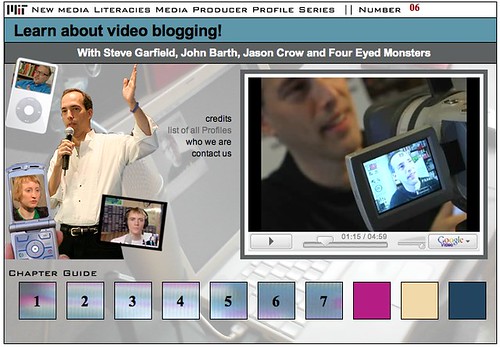Video cameras became popular in developed countries in the early Nineteen Eighties. But personal video diaries published to mass audiences didn't appear until much later, in 1993, when BBC's television series Video Nation gave Hi-8 video cameras for one year to select individuals across the commonwealth, during which time they filmed their everyday lives. More than 10,000 video tapes were recorded and sent to the BBC, from which approximately 1,300 videos were edited and shown on T.V. [via Wikipedia's entry on vlogging [1]]
The first video blogs or ‘vlogs’ (using video for blogging) started to appear as late as 2004. Finding a hosting solution to the large video files was still a problem. With the increasing popularity of YouTube [2] in 2005, internet users had access to the free uploading of videos and could now easily embed those videos in their blogs for distribution. Soon, similar sites emerged to cater the growing number of video publishing enthusiasts. With the proliferation of devices like the video iPod, the vlog revolution soon reached a million videos online [3]. Many of today's mobile phones are now equipped with high quality video options which are increasingly being used by vloggers and as a citizen media tool. Mainstream media outlets, like CNN's iReport [4], also make spaces for citizen journalists to share and distribute their videos.
Videos are increasingly being used as an advocacy tool by citizen media activists around the world. Sites like Witness [5] uses videos and online technologies to expose human rights violations across the world. In places like Tibet where media is censored the citizen media video reports [6] are one of the only ways to know what is happening.
Although online video is revolutionizing how we find out about the world around us, the tool is still predominantly concentrated in the developed world. The challenges of video blogging in developing countries are manifold. Bandwidth is still an issue in many countries in Africa and parts of Asia. Internet speed is still in the dial-up era in many countries, making simple text blogging with images difficult enough. Will the developing world be left out of the digital video revolution?
If citizen media activists are aware of bandwidth and compressions they can overcome the bandwidth problem. This wiki guide [7] by Beth Kanter uses Cambodia as a case-study of how to upload video from regions with slow internet connectivity. It has also lots of great tips about shooting, editing, uploading, hosts and compression.

Photo by Steve Garfield [8], published under a creative commons license [9].
To learn about video blogging check the MIT New Media Literacies Media Producer Profile Series [10].
Make internet TV [11] is also a comprehensive guide which has step-by-step instructions for shooting, editing, and publishing online videos that can be watched and subscribed by millions of people.
There are already great grassroot projects working with video in the developing world, such as two of the finalists of Stockholm challenge [12] from Bangladesh and India:
Unnayan TV:
Unnayan TV [13] (Development TV) is the first Bangladesh online video channel which publishes video contents on development, human rights and educational issues related to Bangladesh. With the motto “Local content and global voice” it features glimpses of the the unreported Bangladesh and has plans to create a space for marginalized communities to make their own voices heard.
It is a non-profit project of Machizo, a multimedia and communication organisation in Dhaka, and receives no outside funding. The videos published so far are the work of Machizo staff and the students of Media Studies and Journalism at the University of Liberal Arts of Bangladesh (ULAB [15]) where Machizo founder Mr. Shahjahan Siraj teaches multimedia.
Digital Green:
Digital Green [16] is a project of Microsoft Research that seeks to disseminate targeted agricultural information to small-scale, rural farmers in India through digital video. The system includes a digital video database, which is produced by farmers and experts. The content within this repository is meant to enable farmers to progressively improve their trade.
Launched in September 2006 by Microsoft Research India's “Technology for Emerging Markets” team, a live deployment of a prototype is currently in development with the GREEN Foundation [17] in villages near the Karanataka and Tamil Nadu-state borders in India.
The scope of Digital Green is the popularization of sustainable farming practices in the 12 villages in which the system is currently deployed and it demonstrated early successes [18].
Do you know of other video blogging projects in the developing world? Let us know with a comment below.